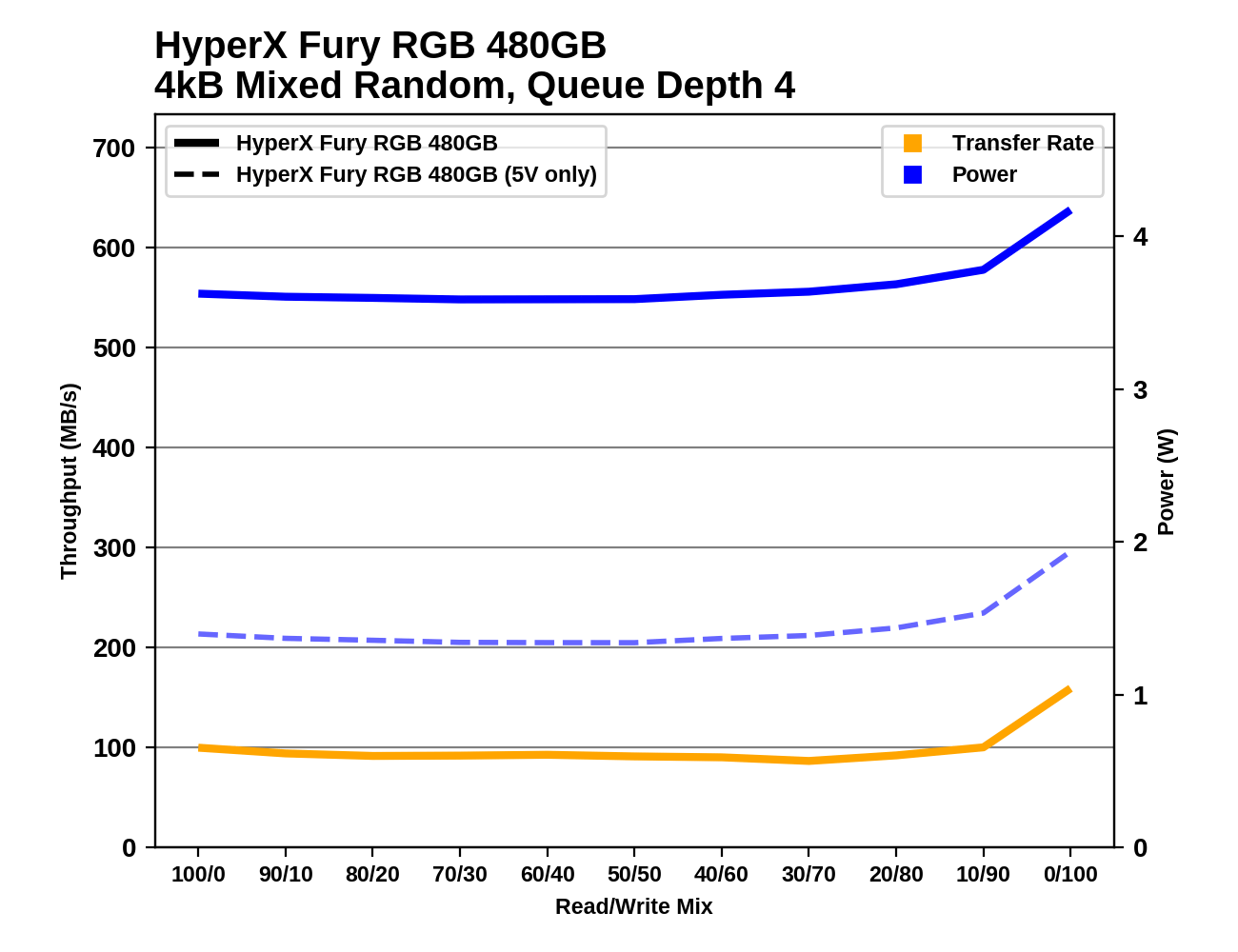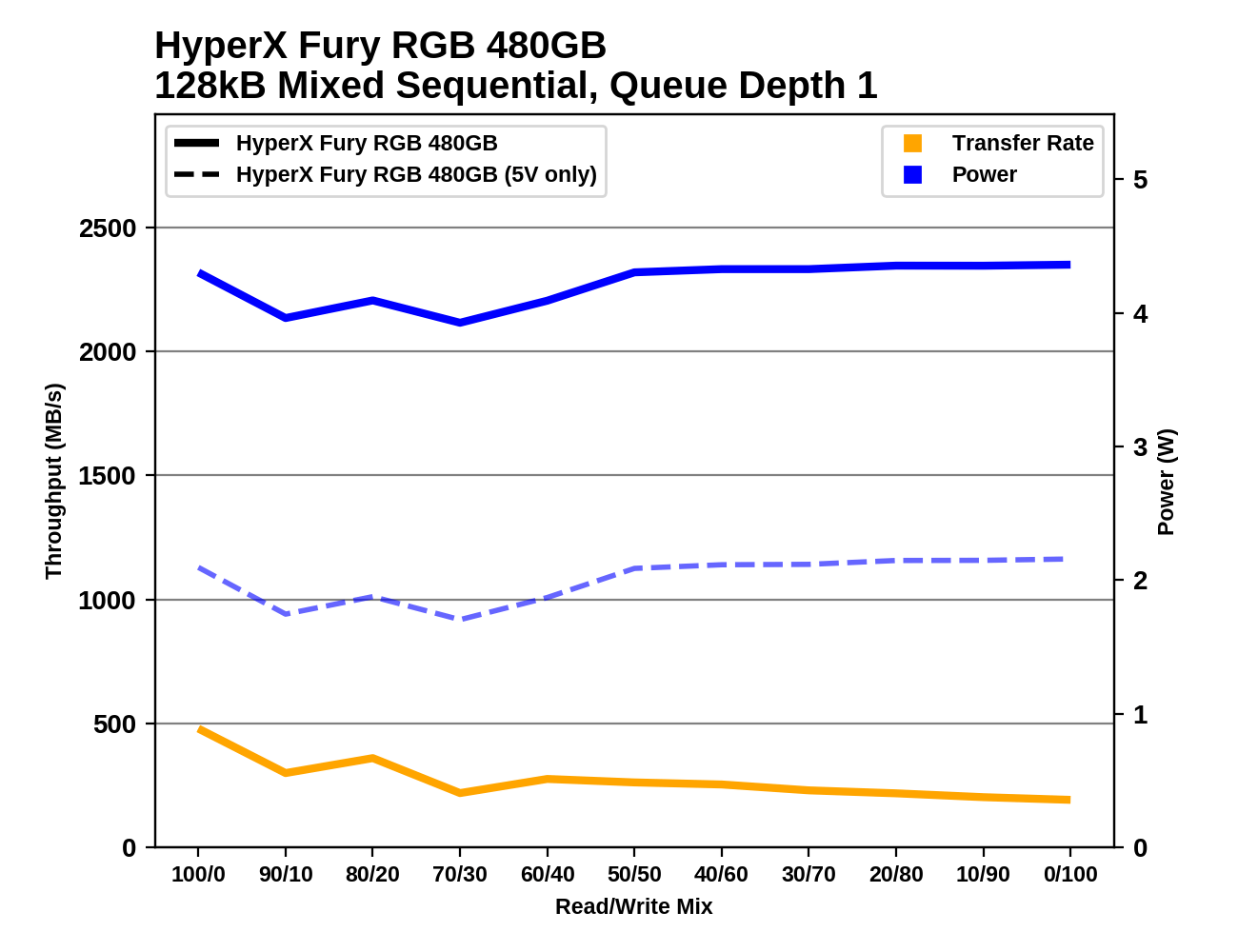The Kingston HyperX Fury RGB SSD Review: Bright Idea, Dimmed Performance
by Billy Tallis on September 24, 2018 8:35 AM ESTMixed Random Performance
Our test of mixed random reads and writes covers mixes varying from pure reads to pure writes at 10% increments. Each mix is tested for up to 1 minute or 32GB of data transferred. The test is conducted with a queue depth of 4, and is limited to a 64GB span of the drive. In between each mix, the drive is given idle time of up to one minute so that the overall duty cycle is 50%.

None of the drives in this batch that use Toshiba's BiCS3 3D TLC perform all that well on the mixed random I/O test. The Plextor M8V shows that the HyperX Fury RGB could do a bit better, but at least the Fury RGB is well ahead of the DRAMless Toshiba TR200 on this test.
 |
|||||||||
| Power Efficiency in MB/s/W | Average Power in W | ||||||||
When excluding the power used by the LEDs, the Fury RGB uses a bit less power on this test than most mainstream SATA SSDs. But the performance is low enough that the efficiency rating is still substantially lower than mainstream competition like the Crucial MX500.
 |
|||||||||
The performance and power consumption of the Fury RGB on the mixed random I/O test are both fairly steady throughout the test save for the typical jump at the end of the test when the workload shifts to pure random writes. Most mainstream drives deliver gradually increasing performance over the course of the test as the proportion of writes increases, and even some of the other BiCS3-based drives make significant gains during the last third of the test.
Mixed Sequential Performance
Our test of mixed sequential reads and writes differs from the mixed random I/O test by performing 128kB sequential accesses rather than 4kB accesses at random locations, and the sequential test is conducted at queue depth 1. The range of mixes tested is the same, and the timing and limits on data transfers are also the same as above.

On the mixed sequential I/O test we again see the HyperX Fury RGB performing like a DRAMless SSD with at least 20% lower performance than most mainstream SATA SSDs.
 |
|||||||||
| Power Efficiency in MB/s/W | Average Power in W | ||||||||
The storage side of the Fury RGB consumes the normal amount of power for a mainstream SATA SSD on this test, so ends up with a clear last-place efficiency score. The DRAMless drives that perform similarly to the Fury RGB consume much less power and have above-average efficiency.
 |
|||||||||
During the first third of the mixed sequential I/O test the performance of the HyperX Fury RGB is inconsistent. As the proportion of writes in the workload increases, the drive settles down into a gradual decline in performance that keeps it just above the Toshiba TR200.










45 Comments
View All Comments
TitanX - Tuesday, September 25, 2018 - link
i have an asus x470 prime..it has a turn off lights thing in the bios.mr_tawan - Monday, September 24, 2018 - link
I'm looking for a new SSD for my laptop. This might be a good fit ...Oh wait, my laptop has no glass panel.
Lolimaster - Monday, September 24, 2018 - link
Blame your laptop manufacturer for not making the mobo pcb and you keyboard clear :Ddcole001 - Monday, September 24, 2018 - link
All Flash and I recommend to Pass!! Just go with the Samsung 860 Series SSD Drive and you will have the best SSD Drive you can get for Desktops.jabbadap - Monday, September 24, 2018 - link
Or crucial mx500, at least it's cheaper than samsung where I live.Lolimaster - Monday, September 24, 2018 - link
On amazon the difference is about $10-20. EVO's got twice the endurance.But MX500 got hardware powerloss protection (physical capacitors).
TitanX - Tuesday, September 25, 2018 - link
man, unless you are doing enterprise workloads or 4k video edit, that whole endurance thing on 500gb+ SSDs is a moot point now. i had a 5 year old Mushkin Chronos deluxe 240GB SSD as a primary drive and only wrote 37 TB in that time. i have a 1TB crucial M2 now and its endurance is multiples of that..i'll replace with with the next big thing or whatever long before it konks out on endurance.casperes1996 - Monday, September 24, 2018 - link
I really don't get the RGB thing... It really isn't even pleasant to look at, and in a lot of cases you lock it away in a non-see-through case anyway. I'd much rather just have a sleek and simple design like the old Cheese Grater Mac Pro than pay extra for flashing lights on everything. I'm willing to pay extra for a great, simple design. But not for lights that ruin the aesthetic. Red lights would disturb my peripheral vision. Keyboard backlighting I can get behind since that serves a good purpose and can look good in the dark when the purpose is there. RGB on GPUs, SSDs, RAM etc. I don't understand.seamonkey79 - Tuesday, September 25, 2018 - link
I'm not huge on RGB, but it's kind of funny that you would mention buying a Mac of any type, which is going to cost more than anything (I've seen) that uses RGB in the Wintel world (for the same hardware).rpmurray - Monday, September 24, 2018 - link
I'm waiting for them to include a radio receiver so that the lights can pulse to the beat of your favorite FM station.